11 Using Brushes to Create a Poster
Lesson overview
In this lesson, you’ll learn how to do the following:
-
Use four brush types: Calligraphic, Art, Bristle, and Pattern.
-
Apply brushes to paths.
-
Paint and edit paths with the Paintbrush tool.
-
Create an Art brush from a raster image.
-
Change brush color and adjust brush settings.
-
Create new brushes from Adobe Illustrator artwork.
-
Work with the Blob Brush tool and the Eraser tool.

This lesson takes approximately 60 minutes to complete. Please log in to your account
on peachpit.com to download the lesson files for this chapter, or go to the “Getting Started” section
at the beginning of this book and follow the instructions under “Accessing the lesson
files and Web Edition.”
Your Account page is also where you’ll find any updates to the chapters or to the
lesson files. Look on the Lesson & Update Files tab to access the most current content.
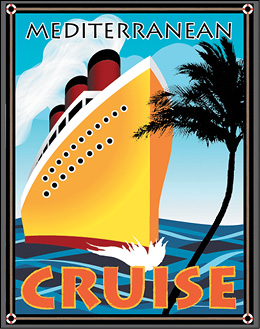
The variety of brush types in Adobe Illustrator CC lets you create a myriad of effects
simply by painting or drawing using the Paintbrush tool or the drawing tools. You
can work with the Blob Brush tool; choose from the Art, Calligraphic, Pattern, Bristle,
or Scatter brushes; or create new brushes based on your artwork.
Starting the lesson
In this lesson, you will learn how to work with the different brush types in the Brushes
panel and how to change brush options and create your own brushes. Before you begin,
you’ll restore the default preferences for Adobe Illustrator CC. Then you’ll open
the finished art file for the lesson to see the finished artwork.
-
To ensure that the tools function and the defaults are set exactly as described in
this lesson, delete or deactivate (by renaming) the Adobe Illustrator CC preferences
file. See “Restoring default preferences” in the “Getting Started” section at the
beginning of the book.
 Note: If you have not already downloaded the project files for this lesson to your computer
from your Account page, make sure to do so now. See the “Getting Started” section
at the beginning of the book.
Note: If you have not already downloaded the project files for this lesson to your computer
from your Account page, make sure to do so now. See the “Getting Started” section
at the beginning of the book.
-
Start Adobe Illustrator CC.
-
Choose File > Open. In the Open dialog box, navigate to the Lessons > Lesson11 folder,
and select the L11_end.ai file on your hard disk. Click Open to open the file.
-
If you want, choose View > Zoom Out to make the finished artwork smaller and then
adjust the window size and leave the artwork on your screen as you work. (Use the
Hand tool [ ] to move the artwork to where you want it in the Document window.) If you don’t want
to leave the artwork open, choose File > Close.
] to move the artwork to where you want it in the Document window.) If you don’t want
to leave the artwork open, choose File > Close.
To begin working, you’ll open an existing art file.
-
Choose File > Open. In the Open dialog box, navigate to the Lessons > Lesson11 folder,
and select the L11_start.ai file on your hard disk. Click Open to open the file.
-
Choose View > Fit Artboard In Window.
-
Choose File > Save As. In the Save As dialog box, name the file CruisePoster.ai, and select the Lesson11 folder. Leave the Format option set to Adobe Illustrator
(ai) (macOS) or the Save As Type option set to Adobe Illustrator (*.AI) (Windows)
and then click Save.
-
In the Illustrator Options dialog box, leave the Illustrator options at their default
settings and then click OK.
-
Choose Reset Essentials from the workspace switcher in the Application bar to reset
the workspace.
 Note: If you don’t see Reset Essentials in the workspace switcher menu, choose Window >
Workspace > Essentials before choosing Window > Workspace > Reset Essentials.
Note: If you don’t see Reset Essentials in the workspace switcher menu, choose Window >
Workspace > Essentials before choosing Window > Workspace > Reset Essentials.
Working with brushes
Using brushes you can decorate paths with patterns, figures, brush strokes, textures,
or angled strokes. You can modify the brushes provided with Illustrator and create
your own brushes.
You can apply brush strokes to existing paths, or you can use the Paintbrush tool
to draw a path and apply a brush stroke simultaneously. You can change the color,
size, and other features of a brush, and you can edit paths after brushes are applied
(including adding a fill).
- Calligraphic brush
- Art brush
- Bristle brush
- Pattern brush
- Scatter brush
 Tip: To learn more about Scatter brushes, search for “Scatter brushes” in Illustrator
Help (Help > Illustrator Help).
Tip: To learn more about Scatter brushes, search for “Scatter brushes” in Illustrator
Help (Help > Illustrator Help).
There are five types of brushes that appear in the Brushes panel (Window > Brushes):
Calligraphic, Art, Bristle, Pattern, and Scatter. In this lesson, you will discover
how to work with all of these except for the Scatter brush.
- Brushes
- Brush Libraries Menu
- Libraries panel
- Remove Brush Stroke
- Options of selected object
- New Brush
- Delete Brush
Using Calligraphic brushes
The first type of brush you’ll learn about is a Calligraphic brush. Calligraphic brushes
resemble strokes drawn with the angled point of a calligraphic pen. Calligraphic brushes
are defined by an elliptical shape whose center follows the path, and you can use
these brushes to create the appearance of hand-drawn strokes made with a flat, angled
pen tip.
Calligraphic brush examples
Applying a Calligraphic brush to artwork
To get started, you’ll filter the type of brushes shown in the Brushes panel so that
it shows only Calligraphic brushes.
-
Choose Window > Brushes to show the Brushes panel. Click the Brushes panel menu icon
( ), and choose List View.
), and choose List View.
-
Click the Brushes panel menu icon ( ) again, and deselect Show Art Brushes, Show Bristle Brushes, and Show Pattern Brushes,
leaving only the Calligraphic brushes visible in the Brushes panel. You can’t deselect
them all at once, so you’ll have to keep clicking the menu icon (
) again, and deselect Show Art Brushes, Show Bristle Brushes, and Show Pattern Brushes,
leaving only the Calligraphic brushes visible in the Brushes panel. You can’t deselect
them all at once, so you’ll have to keep clicking the menu icon ( ) to access the menu.
) to access the menu.
 Note: A checkmark next to the brush type in the Brushes panel menu indicates that the brush
type is visible in the panel.
Note: A checkmark next to the brush type in the Brushes panel menu indicates that the brush
type is visible in the panel.
-
Select the Selection tool ( ) in the Tools panel, and Shift-click both of the two curved pink paths above the
orange/yellow shape of a ship to select both of them.
) in the Tools panel, and Shift-click both of the two curved pink paths above the
orange/yellow shape of a ship to select both of them.
-
Select the 5 pt. Flat brush in the Brushes panel to apply it to the pink paths.
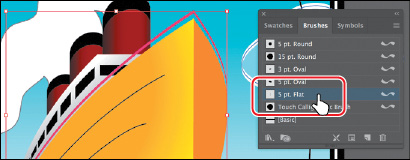
-
Change the Stroke weight to 6 pt in the Properties panel. Click the Stroke color in the Properties panel, make sure
the Swatches option ( ) is selected, and select White. Press the Escape key to hide the Swatches panel,
if necessary.
) is selected, and select White. Press the Escape key to hide the Swatches panel,
if necessary.
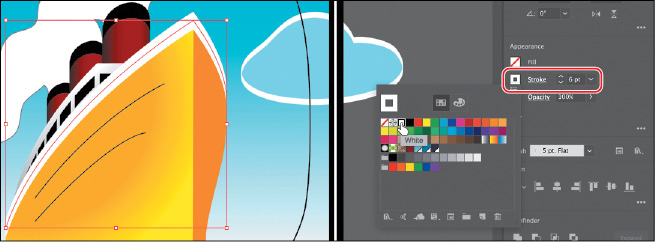
 Note: Like drawing with an actual calligraphic pen, when you apply a Calligraphic brush,
such as the 5 pt. Flat brush, the more vertically the path is drawn, the thinner the
path’s stroke appears.
Note: Like drawing with an actual calligraphic pen, when you apply a Calligraphic brush,
such as the 5 pt. Flat brush, the more vertically the path is drawn, the thinner the
path’s stroke appears.
-
Choose Select > Deselect.
-
With the Selection tool, click the smaller of the white paths (an arrow is pointing
to it in the figure) that you just applied the brush to. Change the stroke color to
a light gray in the Properties panel (I chose the color with the tooltip value “C=0,
M=0, Y=0, K=10”).

-
Choose Select > Deselect and then choose File > Save.
Drawing with the Paintbrush tool
As mentioned earlier, the Paintbrush tool allows you to apply a brush as you paint.
Painting with the Paintbrush tool creates vector paths that you can edit with the
Paintbrush tool or other drawing tools. Next, you’ll use the Paintbrush tool to paint
waves in the water with a calligraphic brush from a default brush library. Your waves
won’t look identical to what you see in the lesson, and that’s okay—just have some fun.
-
With the Selection tool ( ), click the darker blue water shape below the ship.
), click the darker blue water shape below the ship.
-
Choose Select > Deselect.
The water shape is on a sublayer behind the ship. Selecting the water shape selects
that sublayer in the Layers panel, which means that all of the waves you create will
also be on the same sublayer as the water shape.
-
Select the Paintbrush tool ( ) in the Tools panel.
) in the Tools panel.
-
Click the Brush Libraries Menu button ( ) at the bottom of the Brushes panel, and choose Artistic > Artistic_Calligraphic.
A brush library panel with various brushes appears.
) at the bottom of the Brushes panel, and choose Artistic > Artistic_Calligraphic.
A brush library panel with various brushes appears.
Illustrator comes with a host of brush libraries that you can use in your artwork.
Each of the brush types discussed previously has a series of libraries to choose from.
-
Click the Artistic_Calligraphic panel menu icon ( ), and choose List View. Click the brush named “50 pt. Flat” to add it to the Brushes
panel.
), and choose List View. Click the brush named “50 pt. Flat” to add it to the Brushes
panel.
-
Close the Artistic_Calligraphic brush library.
Selecting a brush from a brush library, such as the Artistic_Calligraphic library,
adds that brush to the Brushes panel for the active document only.
-
Change the fill color to None ( ), the stroke color to the swatch named “Dark Blue,” and the stroke weight to 1 pt (if necessary) in the Properties panel.
), the stroke color to the swatch named “Dark Blue,” and the stroke weight to 1 pt (if necessary) in the Properties panel.
Notice that the Paintbrush pointer has an asterisk next to it ( ), indicating that you are about to paint a new path.
), indicating that you are about to paint a new path.
-
Position the pointer off the left side of the artboard, just below the ship. Paint
a long, curving path from left to right, stopping about halfway across the water (see
the figure). Try creating three more paths, painting from left to right, going all
the way across the water. You can see the figure for ideas on how I painted.
 Note: This Calligraphic brush creates random angles on the paths, so yours may not look
like what you see in the figures, and that’s okay.
Note: This Calligraphic brush creates random angles on the paths, so yours may not look
like what you see in the figures, and that’s okay.

-
Choose Select > Deselect (if necessary) and then choose File > Save.
Editing paths with the Paintbrush tool
Now you’ll use the Paintbrush tool to edit one of the paths you painted.
-
Select the Selection tool ( ) in the Tools panel, and click to select the first path you drew on the water (the
one that is just below the bottom of the ship).
) in the Tools panel, and click to select the first path you drew on the water (the
one that is just below the bottom of the ship).
-
Select the Paintbrush tool ( ) in the Tools panel. Position the pointer near the right end of the selected path.
An asterisk will not appear next to the pointer when it’s positioned over a selected path. Drag to the
right to extend the path all the way to the right edge of the artboard. The selected
path is edited from the point where you began drawing.
) in the Tools panel. Position the pointer near the right end of the selected path.
An asterisk will not appear next to the pointer when it’s positioned over a selected path. Drag to the
right to extend the path all the way to the right edge of the artboard. The selected
path is edited from the point where you began drawing.

-
Press and hold the Command (macOS) or Ctrl (Windows) key to toggle to the Selection
tool, and click to select another curved path you drew with the Paintbrush tool. After
clicking, release the key to return to the Paintbrush tool.
-
With the Paintbrush tool, move the pointer over some part of the selected path. When
the asterisk disappears next to the pointer, drag to the right to redraw the path.
-
Choose Select > Deselect (if necessary) and then choose File > Save.
Next, you will edit the Paintbrush tool options.
-
Double-click the Paintbrush tool ( ) in the Tools panel to display the Paintbrush Tool Options dialog box, and make the
following changes:
) in the Tools panel to display the Paintbrush Tool Options dialog box, and make the
following changes:
-
Click OK.
The Paintbrush Tool Options dialog box changes the way the Paintbrush tool functions.
For the Fidelity option, the closer to Smooth you drag the slider, the smoother the
path will be with fewer points. Also, because you selected Keep Selected, the paths
remain selected after you finish drawing them.
-
Change the stroke color to the swatch named “Medium Blue,” and change the stroke weight
to 0.5 pt in the Properties panel.
-
With the Paintbrush tool selected, paint three or four more paths from either left
to right or right to left across the water shape below the ship.
Notice that after painting each path, the path is still selected, so you could edit
it if you needed. I already deselected in the figure.
-
Double-click the Paintbrush tool in the Tools panel. In the Paintbrush Tool Options
dialog box, deselect the Keep Selected option, and then click OK.
Now the paths will not remain selected after you finish drawing them, and you can draw overlapping paths
without altering previously drawn paths.
-
Choose Select > Deselect and then choose File > Save.
Editing a brush
To change the options for a brush, you can double-click the brush in the Brushes panel.
When you edit a brush, you can also choose whether to change artwork to which the
brush has been applied. Next, you’ll change the appearance of the 50 pt. Flat brush
you’ve been painting with.
-
In the Brushes panel, double-click the brush thumbnail to the left of the text “50
pt. Flat” or to the right of the name in the Brushes panel to open the Calligraphic
Brush Options dialog box.
 Note: The edits you make will change the brush for this document only.
Note: The edits you make will change the brush for this document only.
-
In the dialog box, make the following changes:
-
Name: 30 pt. Flat
-
Angle: 0°
-
Choose Fixed from the menu to the right of Angle. (When Random is chosen, a random
variation of brush angles is created every time you draw.)
-
Roundness: 5% (the default setting)
-
Size: 30 pt
 Tip: The Preview window in the dialog box (below the Name field) shows the changes that
you make to the brush.
Tip: The Preview window in the dialog box (below the Name field) shows the changes that
you make to the brush.
-
Click OK.
-
In the dialog box that appears, click Leave Strokes so as not to apply the brush change
to the existing waves that have the brush applied.
-
Change the stroke color to the swatch named “Light Blue,” and change the stroke weight
to 1 pt in the Properties panel.
-
Click the 30 pt. Flat brush in the Brushes panel to ensure that you will paint with
it applied. With the Paintbrush tool ( ) selected, paint three paths across the water to create more waves, overlapping the
existing waves.
) selected, paint three paths across the water to create more waves, overlapping the
existing waves.
-
Choose Select > Deselect, if necessary, and then choose File > Save.
 Note: The artwork should be deselected already, and, if it is, the Deselect command will
be dimmed (you can’t select it).
Note: The artwork should be deselected already, and, if it is, the Deselect command will
be dimmed (you can’t select it).
Removing a brush stroke
You can easily remove a brush stroke applied to artwork where you don’t want it. Now
you’ll remove the brush stroke on the cloud.
-
Select the Selection tool ( ), and click the blue cloud with the white stroke.
), and click the blue cloud with the white stroke.
-
Click the Remove Brush Stroke button ( ) at the bottom of the Brushes panel.
) at the bottom of the Brushes panel.
Removing a brush stroke doesn’t remove the stroke color and weight; it just removes
the brush applied.
 Note: The figure shows the result of clicking the Remove Brush Stroke button.
Note: The figure shows the result of clicking the Remove Brush Stroke button.
-
Change the stroke weight to 0 pt in the Properties panel.
-
Choose Select > Deselect and then choose File > Save.
Using Art brushes
Art brushes stretch artwork or an embedded raster image evenly along the length of
a path. As with other brushes, you can edit the brush options to affect how the brush
is applied to artwork.
Art brush examples
Applying an existing Art brush
Next, you’ll apply an existing Art brush to waves at the front of the boat.
-
In the Brushes panel, click the Brushes panel menu icon ( ), and deselect Show Calligraphic Brushes. Then select Show Art Brushes from the same
panel menu to make the art brushes visible in the Brushes panel.
), and deselect Show Calligraphic Brushes. Then select Show Art Brushes from the same
panel menu to make the art brushes visible in the Brushes panel.
-
Click the Brush Libraries Menu button ( ) at the bottom of the Brushes panel, and choose Artistic > Artistic_Paintbrush.
) at the bottom of the Brushes panel, and choose Artistic > Artistic_Paintbrush.
-
Click the Artistic_Paintbrush panel menu icon ( ), and choose List View. Click the brush named “Brush 3” in the list to add the brush
to the Brushes panel for this document. Close the Artistic_Paintbrush panel group.
), and choose List View. Click the brush named “Brush 3” in the list to add the brush
to the Brushes panel for this document. Close the Artistic_Paintbrush panel group.
-
Select the Paintbrush tool ( ) in the Tools panel.
) in the Tools panel.
-
Change the fill color to None ( ), the stroke color to White (if necessary), and the stroke weight to 1 pt (if necessary) in the Properties panel.
), the stroke color to White (if necessary), and the stroke weight to 1 pt (if necessary) in the Properties panel.
-
Click the Layers panel tab on the right side of the workspace to open the Layers panel.
Click the Spray/Tree sublayer so that the new artwork is on that layer. Click the
Properties panel tab to show that panel again.
-
Position the Paintbrush pointer ( ) at the bottom front of the ship in the red area (marked with an X in the following
figure). Drag to the left along the bottom of the red strip on the ship, just along
the water line. See the figure for how I painted it, and don’t worry about being exact.
You can always choose Edit > Undo Art Stroke and repaint the path.
) at the bottom front of the ship in the red area (marked with an X in the following
figure). Drag to the left along the bottom of the red strip on the ship, just along
the water line. See the figure for how I painted it, and don’t worry about being exact.
You can always choose Edit > Undo Art Stroke and repaint the path.
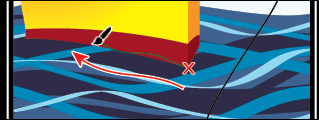
 Tip: With the Paintbrush pointer selected, press the Caps Lock key to see a precise cursor
(X). In certain situations, this can help to paint with more precision.
Tip: With the Paintbrush pointer selected, press the Caps Lock key to see a precise cursor
(X). In certain situations, this can help to paint with more precision.
-
Paint a path from the same starting point (the red X in the previous figure), but drag to the right this time.
-
Paint a “U” shape from left to right to cover any red showing. See the figure—start
at the X in the figure for the “U” shape.
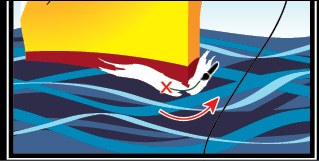
-
Try adding a few more painted paths, always starting from the same point as the original
path you painted.
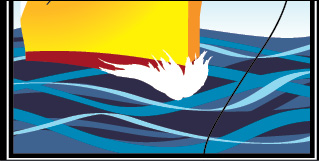
-
Choose File > Save.
Creating an Art brush using a raster image
 Note: To learn about guidelines for creating brushes, see “Create or modify brushes” in
Illustrator Help (Help > Illustrator Help).
Note: To learn about guidelines for creating brushes, see “Create or modify brushes” in
Illustrator Help (Help > Illustrator Help).
 Note: You may need to click the Options button on macOS to see the Link option.
Note: You may need to click the Options button on macOS to see the Link option.
In this section, you’ll place a raster image and embed it so you can create a new
Art brush from it. Images you use in an art brush cannot be linked.
-
Choose File > Place. In the Place dialog box, navigate to the Lesson11 folder, and
select the image named tree.psd. Make sure to deselect the Link option. Click Place.
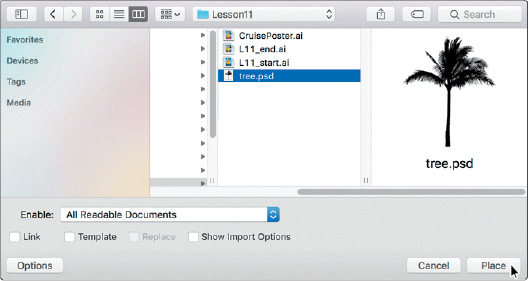
-
Move the pointer off of the right edge of the artboard. Click to place the image.
Next, you’ll make an Art brush from the selected artwork. You can make an Art brush
from vector artwork or from embedded raster images, but that artwork must not contain
gradients, blends, other brush strokes, mesh objects, graphs, linked files, masks,
or text that has not been converted to outlines.
 Note: When dealing with embedded images and brushes, there is a direct impact on the performance
of the document in Illustrator. There is a fixed limit to the size of the embedded
image that can be used for a brush. You may see a dialog box telling you that the
image needs to be resampled before you can make a brush from it.
Note: When dealing with embedded images and brushes, there is a direct impact on the performance
of the document in Illustrator. There is a fixed limit to the size of the embedded
image that can be used for a brush. You may see a dialog box telling you that the
image needs to be resampled before you can make a brush from it.
-
Select the Selection tool ( ). Choose Window > Brushes to open the Brushes panel, if it isn’t open already. With
the placed image still selected, click the New Brush button (
). Choose Window > Brushes to open the Brushes panel, if it isn’t open already. With
the placed image still selected, click the New Brush button ( ) at the bottom of the Brushes panel. This begins the process of creating a new brush
from the selected raster artwork.
) at the bottom of the Brushes panel. This begins the process of creating a new brush
from the selected raster artwork.
-
In the New Brush dialog box, select Art Brush and then click OK.
-
In the Art Brush Options dialog box that appears, change the name to Palm Tree. Click OK.
-
Delete the image you placed off the right side of the artboard since you don’t need
it anymore.
-
With the Selection tool selected, click to select the curved black line to the right
of the ship.
-
Click the brush named “Palm Tree” in the Brushes panel to apply it.
Notice that the original tree image is stretched along the path. This is the default
behavior of an Art brush.
Editing an Art brush
Next, you’ll edit the Palm Tree Art brush and update the appearance of the palm tree
on the artboard.
-
With the curved path still selected on the artboard, double-click the brush thumbnail
to the left of the text “Palm tree” or to the right of the name in the Brushes panel
to open the Art Brush Options dialog box.
 Tip: To learn more about the Art Brush Options dialog box, see “Art brush options” in
Illustrator Help (Help > Illustrator Help).
Tip: To learn more about the Art Brush Options dialog box, see “Art brush options” in
Illustrator Help (Help > Illustrator Help).
-
In the Art Brush Options dialog box, select Preview to see the changes as you make
them, and move the dialog box so you can see the curvy line with the brush applied.
Make the following changes:
-
Click OK.
-
In the dialog box that appears, click Apply To Strokes to apply the change to the
curvy line that has the Palm Tree brush applied.
-
Click the word “Opacity” in the Properties panel, and choose Multiply from the Blend
Mode menu. Press Enter or Return to close the Transparency panel.
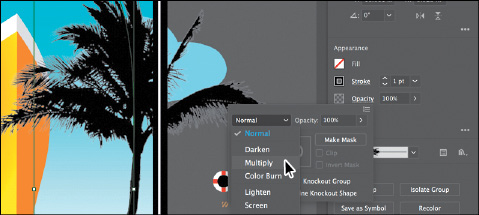
-
Choose Select > Deselect and then choose File > Save.
Using Bristle brushes
Bristle brushes allow you to create strokes with the appearance of a natural brush
with bristles. Painting with a Bristle brush, using the Paintbrush tool, creates vector
paths with the Bristle brush applied.
In this section, you’ll start by adjusting options for a brush to change how it appears
in the artwork and then paint with the Paintbrush tool and a Bristle brush to create
smoke.
Bristle brush examples
Changing Bristle brush options
 Note: To learn more about the Bristle Brush Options dialog box and its settings, see “Using
the Bristle brush“ in Illustrator Help (Help > Illustrator Help).
Note: To learn more about the Bristle Brush Options dialog box and its settings, see “Using
the Bristle brush“ in Illustrator Help (Help > Illustrator Help).
As you’ve seen, you can change the appearance of a brush by adjusting its settings
in the Brush Options dialog box, either before or after brushes have been applied
to artwork. In the case of Bristle brushes, it’s usually best to adjust the brush
settings prior to painting since it can take some time to update the brush strokes.
-
In the Brushes panel, click the panel menu icon ( ), choose Show Bristle Brushes, and then deselect Show Art Brushes.
), choose Show Bristle Brushes, and then deselect Show Art Brushes.
-
Double-click the thumbnail for the default Mop brush or double-click directly to the
right of the brush name in the Brushes panel to change the options for that brush.
In the Bristle Brush Options dialog box, make the following changes:
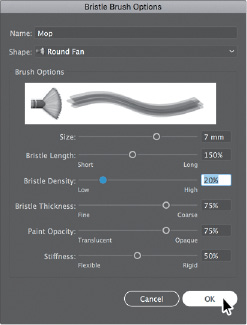
-
Shape: Round Fan (the default setting)
 Tip: Illustrator comes with a series of default Bristle brushes. Click the Brush Libraries
Menu button (
Tip: Illustrator comes with a series of default Bristle brushes. Click the Brush Libraries
Menu button ( ) at the bottom of the Brushes panel, and choose Bristle Brush > Bristle Brush Library.
) at the bottom of the Brushes panel, and choose Bristle Brush > Bristle Brush Library.
-
Size: 7 mm (The brush size is the diameter of the brush.)
-
Bristle Length: 150% (the default setting) (The bristle length starts from the point where the bristles
meet the handle of the bristle tip.)
-
Bristle Density: 20% (The bristle density is the number of bristles in a specified area of the brush neck.)
-
Bristle Thickness: 75% (the default setting) (The bristle thickness can vary from fine to coarse [between
1% and 100%].)
-
Paint Opacity: 75% (the default setting) (This option lets you set the opacity of the paint being used.)
-
Stiffness: 50% (the default setting) (Stiffness refers to the rigidness of the bristles.)
-
Click OK.
Painting with a Bristle brush
Now you’ll use the Mop brush to draw some smoke above the ship. Painting with a Bristle
brush can create an organic, fluid path. To constrain the painting, you will paint
inside a shape. This will mask (hide) part of the painting to be in the shape of smoke.
-
Select the Zoom tool ( ) in the Tools panel, and click a few times, slowly, on the smoke shape above the
ship (not the cloud) to zoom in on it.
) in the Tools panel, and click a few times, slowly, on the smoke shape above the
ship (not the cloud) to zoom in on it.
-
Select the Selection tool ( ) in the Tools panel, and click to select the smoke shape. This selects the layer
that the shape is on so that any artwork you paint will be on the same layer.
) in the Tools panel, and click to select the smoke shape. This selects the layer
that the shape is on so that any artwork you paint will be on the same layer.
-
Click the Draw Inside button ( ) at the bottom of the Tools panel.
) at the bottom of the Tools panel.
 Note: If the Tools panel appears as one column, click the Drawing Modes button (
Note: If the Tools panel appears as one column, click the Drawing Modes button ( ) at the bottom of the Tools panel, and then choose Draw Inside from the menu that
appears.
) at the bottom of the Tools panel, and then choose Draw Inside from the menu that
appears.
-
With the smoke shape still selected, change the fill color to None ( ) in the Properties panel (press the Escape key to hide the Swatches panel). Leave
the stroke as is.
) in the Properties panel (press the Escape key to hide the Swatches panel). Leave
the stroke as is.
-
Choose Select > Deselect to deselect the smoke shape.
The dotted lines on the corners of the shape indicate that any paths you paint will
be masked by the smoke shape.
-
Select the Paintbrush tool ( ) in the Tools panel. Choose the Mop brush from the Brush menu in the Properties panel,
if it’s not already chosen.
) in the Tools panel. Choose the Mop brush from the Brush menu in the Properties panel,
if it’s not already chosen.
-
Make sure that the fill color is None ( ) and the stroke color is White in the Properties panel. Press the Escape key to hide
the Swatches panel. Make sure that the stroke weight is 1 pt in the Properties panel.
) and the stroke color is White in the Properties panel. Press the Escape key to hide
the Swatches panel. Make sure that the stroke weight is 1 pt in the Properties panel.
-
Position the pointer at the top of the largest smokestack. (See the red X in the following
figure.) Drag up and then down and to the left to loosely follow the edge of the smoke
shape. Release the mouse button when you reach the end of the smoke shape.
 Tip: If you don’t like what you just painted, you can choose Edit > Undo Bristle Stroke.
Tip: If you don’t like what you just painted, you can choose Edit > Undo Bristle Stroke.
When you release the mouse button, notice that part of the path you just painted is
masked (hidden) by the smoke shape.
 Tip: If you want to edit paths as you draw, you can select the Keep Selected option in
the Paintbrush Tool Options for the Paintbrush tool or you can select paths with the
Selection tool. You don’t need to completely fill the shape.
Tip: If you want to edit paths as you draw, you can select the Keep Selected option in
the Paintbrush Tool Options for the Paintbrush tool or you can select paths with the
Selection tool. You don’t need to completely fill the shape.
-
Use the Paintbrush tool to paint more paths inside the smoke shape, using the Mop
brush. Try drawing from each of the smokestacks, following the smoke shape. The idea
is to fill up the smoke shape with the paths you paint.
 Note: In the first part of the figure, I dimmed the shape paths so you could more easily
see the smoke paths.
Note: In the first part of the figure, I dimmed the shape paths so you could more easily
see the smoke paths.
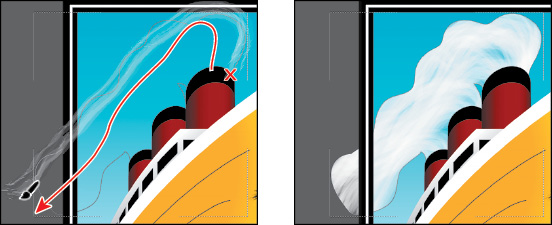
Cleaning up the shapes
Next, you’ll remove the stroke on the smoke shape.
-
Choose View > Outline to see all of the paths you just created when painting.
-
Choose Select > Object > Bristle Brush Strokes to select all of the paths created
with the Paintbrush tool using the Mop brush.
-
Choose Object > Group and then choose View > GPU Preview if supported or View > Preview
On CPU if not.
 Note: If the Tools panel appears as one column, click the Drawing Modes button at the bottom
of the Tools panel and then choose Draw Normal from the menu that appears.
Note: If the Tools panel appears as one column, click the Drawing Modes button at the bottom
of the Tools panel and then choose Draw Normal from the menu that appears.
 Note: Be careful you don’t double-click on the path with the Palm Tree brush applied, since
it may overlap the smoke shape.
Note: Be careful you don’t double-click on the path with the Palm Tree brush applied, since
it may overlap the smoke shape.
-
Click the Draw Normal button ( ) at the bottom of the Tools panel.
) at the bottom of the Tools panel.
-
Select the Selection tool in the Tools panel. Choose Select > Deselect.
-
Double-click in the smoke shape to enter Isolation mode. Click the edge of the original
smoke shape to select it. Change the stroke color to None ( ) in the Properties panel.
) in the Properties panel.
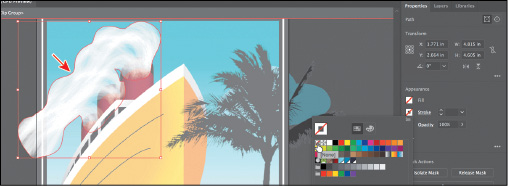
-
Press the Escape key several times to hide the panel and to exit Isolation mode.
 Tip: You can also double-click away from the artwork to exit Isolation mode.
Tip: You can also double-click away from the artwork to exit Isolation mode.
-
Click the Layers tab on the right side of the workspace to show the Layers panel.
Click the eye icon ( ) to the left of the Spray/Tree sublayer name to hide the artwork on that layer. Click
the Properties panel tab to show that panel again.
) to the left of the Spray/Tree sublayer name to hide the artwork on that layer. Click
the Properties panel tab to show that panel again.
-
Choose Select > Deselect and then choose File > Save.
When saving, you may see a warning dialog box indicating that the document contains
multiple Bristle brush paths with transparency. As mentioned earlier, painting with
a Bristle brush creates a series of individual vector paths with the brush applied.
This can lead to issues with printing or saving to EPS/PDF or legacy versions of Illustrator
documents. In order to reduce the complexity and number of the Bristle Brush paths,
you can rasterize paths with a Bristle brush applied. Select the path(s) with the
Bristle brush applied, and choose Object > Rasterize.
Using Pattern brushes
Pattern brushes paint a pattern made up of separate sections, or tiles. When you apply a Pattern brush to artwork, different tiles of the pattern are applied
to different sections of the path, depending on where the section falls on the path—the
end, middle, or corner. There are hundreds of interesting Pattern brushes that you
can choose from when creating your own projects, from grass to cityscapes. Next, you’ll
apply an existing Pattern brush to a path to create windows on the ship.
Pattern brush examples
-
Choose View > Fit Artboard In Window.
-
In the Brushes panel, click the panel menu icon ( ), choose Show Pattern Brushes, and then deselect Show Bristle Brushes.
), choose Show Pattern Brushes, and then deselect Show Bristle Brushes.
The brush named “Windows” that appears in the Brushes panel is a brush that I created
and saved with the file. Next, you’ll apply a Pattern brush, and then edit its properties.
 Tip: Just like other brush types, there is a series of default Pattern brush libraries
that come with Illustrator. To access them, click the Brush Libraries Menu button
(
Tip: Just like other brush types, there is a series of default Pattern brush libraries
that come with Illustrator. To access them, click the Brush Libraries Menu button
( ), and choose a library from one of the menus (the Decorative menu, for example).
), and choose a library from one of the menus (the Decorative menu, for example).
-
With the Selection tool ( ) selected, Shift-click the two black paths on the orange/yellow shape to select them
both.
) selected, Shift-click the two black paths on the orange/yellow shape to select them
both.
-
Select the Windows Pattern brush from the Brushes panel to apply the Pattern brush.
Next, you’ll edit the brush properties for one of the paths.
-
Choose Select > Deselect and then click the bottommost path with the Windows brush
applied to select it.
-
Click the Options Of Selected Object button ( ) in the Properties panel to edit the brush options for only the selected path on
the artboard.
) in the Properties panel to edit the brush options for only the selected path on
the artboard.
-
 Tip: To change the size of the windows, you can also change the stroke weight of the lines
on the artboard, with the brush applied.
Tip: To change the size of the windows, you can also change the stroke weight of the lines
on the artboard, with the brush applied.
Select Preview in the Stroke Options (Pattern Brush) dialog box. Change the Scale
to 110% either by dragging the Scale slider or by typing in the value. Click OK.
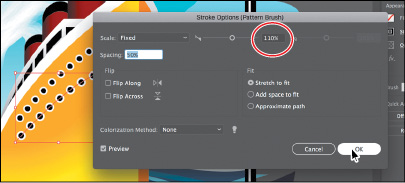
 Tip: You’ll also see the Options Of Selected Object button (
Tip: You’ll also see the Options Of Selected Object button ( ) at the bottom of the Brushes panel.
) at the bottom of the Brushes panel.
When you edit the brush options of the selected object, you only see some of the brush
options. The Stroke Options (Pattern Brush) dialog box is used to edit the properties
of the brushed path without updating the corresponding brush.
-
Choose Select > Deselect and then choose File > Save.
Creating a Pattern brush
You can create a Pattern brush in several ways. For a simple pattern applied to a
straight line, for instance, you can select the content that you’re using for the
pattern and click the New Brush button ( ) at the bottom of the Brushes panel.
) at the bottom of the Brushes panel.
To create a more complex pattern to apply to objects with curves and corners, you
can select artwork in the Document window to be used in a pattern brush, create swatches
in the Swatches panel from the artwork that you are using in the Pattern brush, and
even have Illustrator autogenerate the Pattern brush corners. In Illustrator, only
the side tile needs to be defined. Illustrator automatically generates four different
types of corners based on the art used for the side tile. These four autogenerated
options fit the corners perfectly. Next, you’ll create a Pattern brush for the border
around the poster.
-
Choose View > Pattern objects. This should show you a zoomed-in view of the life preserver
and the rope off the right edge of the artboard.
 Note: You’ll find Pattern Objects at the bottom of the View menu.
Note: You’ll find Pattern Objects at the bottom of the View menu.
-
With the Selection tool ( ) selected, click to select the brown rope group.
) selected, click to select the brown rope group.
-
Click the panel menu icon ( ) in the Brushes panel, and choose Thumbnail View.
) in the Brushes panel, and choose Thumbnail View.
Notice that Pattern brushes in the Brushes panel are segmented in Thumbnail view.
Each segment corresponds to a pattern tile.
-
In the Brushes panel, click the New Brush button ( ) to create a pattern out of the rope.
) to create a pattern out of the rope.
-
In the New Brush dialog box, select Pattern Brush. Click OK.
A new Pattern brush can be made regardless of whether artwork is selected. If you
create a Pattern brush without artwork selected, it is assumed that you will add artwork
by dragging it into the Brushes panel later or by selecting the artwork from a pattern
swatch you create as you edit the brush. You will see the latter method later in this
section.
-
In the Pattern Brush Options dialog box, name the brush Border.
Pattern brushes can have up to five tiles—the side, start, and end tiles, plus an
outer-corner tile and an inner-corner tile to paint sharp corners on a path.
 Note: Some brushes have no corner tiles because they are designed for curved paths.
Note: Some brushes have no corner tiles because they are designed for curved paths.
You can see all five tiles as buttons below the Spacing option in the dialog box.
The tile buttons let you apply different artwork to different parts of the path. You
can click a tile button for the tile you want to define, and then you select an autogenerated
selection (if available) or a pattern swatch from the menu that appears.
 Tip: Selected artwork becomes the side tile, by default, when creating a Pattern brush.
Tip: Selected artwork becomes the side tile, by default, when creating a Pattern brush.
-
Under the Spacing option, click the Side Tile box (the second tile from the left).
The artwork that was originally selected is in the menu that appears, along with None
and any pattern swatches found in the Swatches panel. Choose Pompadour from the menu.
In the Preview area below the tiles, you will see how the new artwork affects a path.
 Tip: Position the pointer over the tile squares in the Pattern Brush Options dialog box
to see a tooltip indicating which tile it is.
Tip: Position the pointer over the tile squares in the Pattern Brush Options dialog box
to see a tooltip indicating which tile it is.
-
Click the Side Tile box again, and choose the option called “Original.”
-
Click the Outer Corner Tile box to reveal the menu.
The outer-corner tile has been generated automatically by Illustrator, based on the
original rope artwork. In the menu, you can choose from four types of corners that
are generated automatically:
-
Auto-Centered. The side tile is stretched around the corner and centered on it.
 Tip: To save a brush and reuse it in another file, you can create a brush library with
the brushes you want to use. For more information, see “Work with brush libraries”
in Illustrator Help.
Tip: To save a brush and reuse it in another file, you can create a brush library with
the brushes you want to use. For more information, see “Work with brush libraries”
in Illustrator Help.
-
Auto-Between. Copies of the side tile extend all the way into the corner, with one copy on each
side. Folding elimination is used to stretch them into shape.
-
Auto-Sliced. The side tile is sliced diagonally, and the pieces come together, similar to a miter
joint in a wooden picture frame.
-
Auto-Overlap. Copies of the tiles overlap at the corner.
-
Choose Auto-Between from the menu. This generates the outer corner of any path that
the Pattern brush will be applied to from the rope.
-
Click OK. The Border brush appears in the Brushes panel.
Applying a Pattern brush
In this section, you’ll apply the Border Pattern brush to a rectangular border around
the artwork. As you’ve seen, when you use drawing tools to apply brushes to artwork,
you first draw the path with the drawing tool and then select the brush in the Brushes
panel to apply the brush to the path.
-
Choose View > Fit Artboard In Window.
-
With the Selection tool ( ) selected, click the white stroke of the rectangle on the border.
) selected, click the white stroke of the rectangle on the border.
-
In the Tools panel, click the Fill box, and make sure that None ( ) is selected. Then click the Stroke box and select None (
) is selected. Then click the Stroke box and select None ( ).
).
-
With the rectangle selected, click the Border brush in the Brushes panel.
-
Choose Select > Deselect.
The rectangle is painted with the Border brush, with the side tile on the sides and
the outer-corner tile on each corner.
Editing the Pattern brush
 Tip: For more information on creating pattern swatches, see “About patterns” in Illustrator
Help.
Tip: For more information on creating pattern swatches, see “About patterns” in Illustrator
Help.
Now you’ll edit the Border Pattern brush using a pattern swatch that you create.
-
Choose Window > Swatches to open the Swatches panel.
-
Choose View > Pattern objects to zoom in to the life preserver off the right edge
of the artboard.
-
With the Selection tool ( ), drag the life preserver into the Swatches panel.
), drag the life preserver into the Swatches panel.
The new pattern swatch appears in the Swatches panel. After you create a pattern brush,
you can delete the pattern swatches from the Swatches panel, if you don’t plan to
use them for additional artwork.
-
Choose Select > Deselect.
-
In the Swatches panel, double-click the pattern swatch that you just created to enter
Pattern Editing mode.
-
In the Pattern Options dialog box, name the swatch Corner.
You don’t have to name the pattern swatch, but it can make it easier to select when
you edit the brush.
-
Click Done in the gray bar, along the top of the Document window, to finish editing
the pattern.
-
Choose View > Fit Artboard In Window.
-
In the Brushes panel (Window > Brushes), double-click the Border Pattern brush to
open the Pattern Brush Options dialog box.
-
Click the Outer Corner Tile box, and choose the Corner pattern swatch from the menu
that appears (you’ll need to scroll). Change Scale from 100% to 70%, and click OK. The figure shows choosing the outer-corner tile.
 Tip: You can also change the pattern tiles in a Pattern brush by pressing the Option (macOS)
or Alt (Windows) key and dragging artwork from the artboard onto the tile of the Pattern
brush you want to change in the Brushes panel.
Tip: You can also change the pattern tiles in a Pattern brush by pressing the Option (macOS)
or Alt (Windows) key and dragging artwork from the artboard onto the tile of the Pattern
brush you want to change in the Brushes panel.
-
In the dialog box that appears, click Apply To Strokes to update the border on the
artboard.
-
With the Selection tool selected, click to select one of the paths that contains a
row of windows. Click the Border brush in the Brushes panel to apply it.
Notice that the life preservers are not applied to the path. The path is painted with
the side tile from the Border brush. Because the path does not include sharp corners,
outer-corner and inner-corner tiles are not applied to the path.
-
Choose Edit > Undo Apply Pattern Brush to remove the brush from the path.
 Note: Earlier in the lesson, you learned how to remove a brush from an object by clicking
the Remove Brush Stroke button (
Note: Earlier in the lesson, you learned how to remove a brush from an object by clicking
the Remove Brush Stroke button ( ) in the Brushes panel. In this case, you chose Edit > Undo Apply Pattern Brush instead,
because clicking the Remove Brush Stroke button would strip the previous formatting
from the path, leaving it with a default fill and stroke.
) in the Brushes panel. In this case, you chose Edit > Undo Apply Pattern Brush instead,
because clicking the Remove Brush Stroke button would strip the previous formatting
from the path, leaving it with a default fill and stroke.
-
Choose Select > Deselect and then choose File > Save.
Working with the Blob Brush tool
You can use the Blob Brush tool ( ) to paint filled shapes that intersect and merge with other shapes of the same color.
With the Blob Brush tool, you can draw with Paintbrush tool artistry. Unlike the Paintbrush
tool, which lets you create open paths, the Blob Brush tool lets you create a closed
shape with a fill only (no stroke) that you can then easily edit with the Eraser or
Blob Brush tool. Shapes that have a stroke cannot be edited with the Blob Brush tool.
) to paint filled shapes that intersect and merge with other shapes of the same color.
With the Blob Brush tool, you can draw with Paintbrush tool artistry. Unlike the Paintbrush
tool, which lets you create open paths, the Blob Brush tool lets you create a closed
shape with a fill only (no stroke) that you can then easily edit with the Eraser or
Blob Brush tool. Shapes that have a stroke cannot be edited with the Blob Brush tool.

Path created with the Paintbrush tool
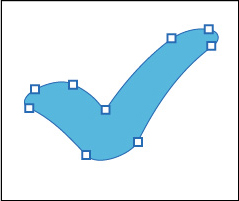
Shape created with the Blob Brush tool
Drawing with the Blob Brush tool
Next, you’ll use the Blob Brush tool to create part of a cloud.
-
Click the Layers panel tab on the right side of the workspace to show the Layers panel.
Click the eye icon ( ) to the left of the Ship sublayer to hide the contents of the layer. Click the Background
sublayer to select it.
) to the left of the Ship sublayer to hide the contents of the layer. Click the Background
sublayer to select it.
-
In the Swatches panel, select the Fill color box and then select the swatch named
“Light Blue.” Select the Stroke color box and select None ( ) to remove the stroke.
) to remove the stroke.
When drawing with the Blob Brush tool, if a fill and stroke are set before drawing,
the stroke color becomes the fill color of the shape made by the Blob Brush tool.
If only a fill is set before drawing, it ultimately becomes the fill of the shape
created.
-
Click and hold down on the Paintbrush tool ( ) in the Tools panel, and select the Blob Brush tool (
) in the Tools panel, and select the Blob Brush tool ( ). Double-click the Blob Brush tool in the Tools panel. In the Blob Brush Tool Options
dialog box, change the following:
). Double-click the Blob Brush tool in the Tools panel. In the Blob Brush Tool Options
dialog box, change the following:
-
Keep Selected: Selected
-
Size: 70 pt
-
Click OK.
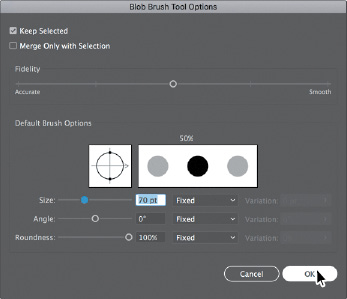
-
Position the pointer to the left of the little blue cloud in the sky. Drag to create
a cloud shape that doesn’t touch the little cloud to the right of it (see the figure).
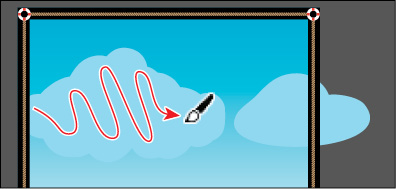
When you draw with the Blob Brush tool, you create filled, closed shapes. Those shapes
can contain any type of fill, including gradients, solid colors, patterns, and more.
Notice that the Blob Brush pointer has a circle around it before you begin painting.
That circle indicates the size of the brush (70 pt, which you set in the previous
step).
 Tip: You can also change the Blob Brush size by pressing the right bracket key ( ] ) or
left bracket key ( [ ) several times to increase or decrease the size of the brush.
Tip: You can also change the Blob Brush size by pressing the right bracket key ( ] ) or
left bracket key ( [ ) several times to increase or decrease the size of the brush.
Merging paths with the Blob Brush tool
In addition to drawing new shapes with the Blob Brush tool, you can use it to intersect
and merge shapes of the same color. Objects merged with the Blob Brush tool need to
have the same appearance attributes, have no stroke, be on the same layer or group,
and be adjacent to each other in the stacking order.
 Note: To learn more about Blob Brush tool guidelines, search for “Painting with fills and
strokes” in Illustrator Help (Help > Illustrator Help). On that Help page, go to the
section titled “Draw and merge paths with the Blob Brush tool.”
Note: To learn more about Blob Brush tool guidelines, search for “Painting with fills and
strokes” in Illustrator Help (Help > Illustrator Help). On that Help page, go to the
section titled “Draw and merge paths with the Blob Brush tool.”
 Note: In the figure, the cloud you drew has a blue outline. You may not see that, and that’s
okay.
Note: In the figure, the cloud you drew has a blue outline. You may not see that, and that’s
okay.
Next, you will merge the cloud you just created with the little cloud to the right
of it to create one big cloud.
-
Choose Select > Deselect.
-
With the Blob Brush tool ( ) selected, drag from inside the cloud shape you created to the inside of the little
cloud to the right, connecting the two shapes.
) selected, drag from inside the cloud shape you created to the inside of the little
cloud to the right, connecting the two shapes.
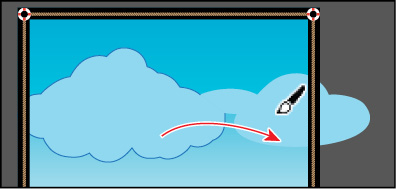
 Note: If you find that the shapes are not merging, it may be that they have different strokes
and fills. You can select both the cloud you created and the small cloud with the
Selection tool (
Note: If you find that the shapes are not merging, it may be that they have different strokes
and fills. You can select both the cloud you created and the small cloud with the
Selection tool ( ) and ensure that the fill color is the light blue swatch and the stroke is None in
the Properties panel. Then you can select the Blob Brush tool and try dragging from
one cloud to the other.
) and ensure that the fill color is the light blue swatch and the stroke is None in
the Properties panel. Then you can select the Blob Brush tool and try dragging from
one cloud to the other.
-
Continue drawing with the Blob Brush tool to make the two clouds look more like a
single cloud.
If you find that new shapes are being made instead of the existing cloud shape being
edited, undo what you’ve created. Then, with the Selection tool ( ), reselect and deselect the cloud shape and continue.
), reselect and deselect the cloud shape and continue.
-
Choose Select > Deselect and then choose File > Save.
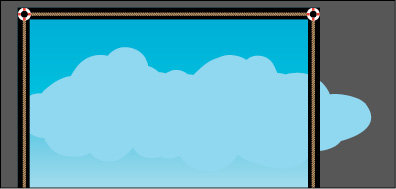
Editing with the Eraser tool
 Tip: As you draw with the Blob Brush and Eraser tools, it is recommended that you use
shorter strokes and release the mouse button often. You can undo the edits that you
make, but if you draw in one long stroke without releasing the mouse button, an undo
removes the entire stroke.
Tip: As you draw with the Blob Brush and Eraser tools, it is recommended that you use
shorter strokes and release the mouse button often. You can undo the edits that you
make, but if you draw in one long stroke without releasing the mouse button, an undo
removes the entire stroke.
As you draw and merge shapes with the Blob Brush tool, you may draw too much and want
to edit what you’ve done. You can use the Eraser tool ( ) in combination with the Blob Brush tool to mold the shape and to correct any changes
you don’t like.
) in combination with the Blob Brush tool to mold the shape and to correct any changes
you don’t like.
-
With the Selection tool ( ), click to select the cloud shape.
), click to select the cloud shape.
Selecting the shape(s) before erasing limits the Eraser tool to erasing only the selected
shape(s).
-
Double-click the Eraser tool ( ) in the Tools panel. In the Eraser Tool Options dialog box, change Size to 40 pt, and click OK.
) in the Tools panel. In the Eraser Tool Options dialog box, change Size to 40 pt, and click OK.
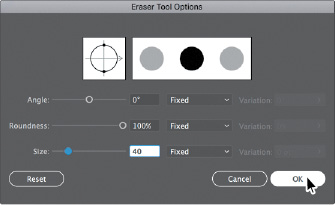
-
Position the pointer over the edge of the cloud shape and, with the Eraser tool, drag
along the bottom of the cloud shape to remove some of it. Try switching between the
Blob Brush tool and the Eraser tool to edit the cloud.
The Blob Brush and Eraser tools both have pointers that include a circle, indicating
the diameter of the brush.
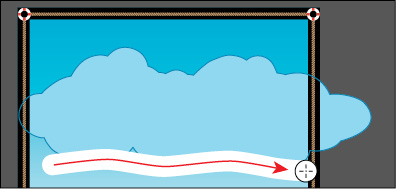
-
Choose Select > Deselect.
-
Click the Layers panel tab on the right side of the workspace to show the Layers panel,
if necessary. Click the visibility columns to the left of all the sublayers to ensure
that they are all showing. Click to select the main layer named “Mask” at the top
of the Layers panel. Click the Make/Release Clipping Mask button ( ) at the bottom of the Layers panel.
) at the bottom of the Layers panel.
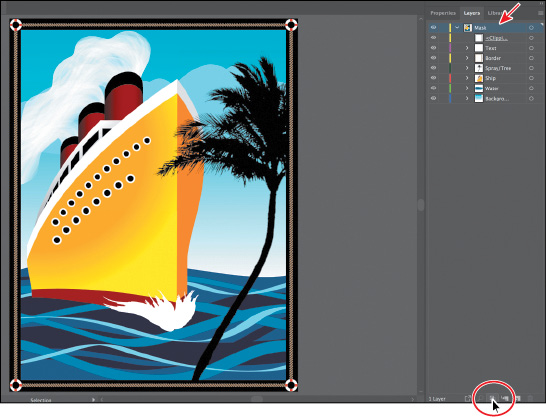
By clicking the Make/Release Clipping Mask button, you are taking an existing rectangle
shape and using it to mask content. To learn more about masking, see Lesson 14, “Using Illustrator CC with Other Adobe Applications.”
-
Choose Object > Show All to show some poster text.
-
Choose Select > Deselect.
-
Choose File > Save, and close all open files.





 ] to move the artwork to where you want it in the Document window.) If you don’t want
to leave the artwork open, choose File > Close.
] to move the artwork to where you want it in the Document window.) If you don’t want
to leave the artwork open, choose File > Close.
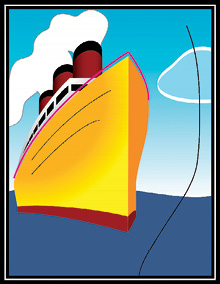
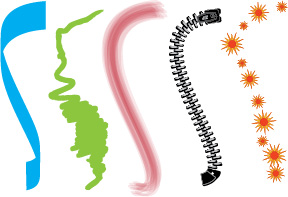

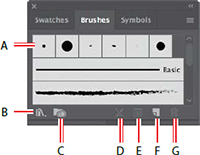
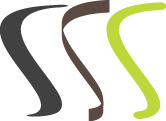
 ), and choose List View.
), and choose List View.
 ) in the Tools panel, and Shift-click both of the two curved pink paths above the
orange/yellow shape of a ship to select both of them.
) in the Tools panel, and Shift-click both of the two curved pink paths above the
orange/yellow shape of a ship to select both of them.

 ) is selected, and select White. Press the Escape key to hide the Swatches panel,
if necessary.
) is selected, and select White. Press the Escape key to hide the Swatches panel,
if necessary.


 ) in the Tools panel.
) in the Tools panel.

 ) at the bottom of the Brushes panel, and choose Artistic > Artistic_Calligraphic.
A brush library panel with various brushes appears.
) at the bottom of the Brushes panel, and choose Artistic > Artistic_Calligraphic.
A brush library panel with various brushes appears.
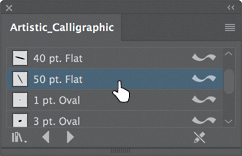
 ), the stroke color to the swatch named “Dark Blue,” and the stroke weight to 1 pt (if necessary) in the Properties panel.
), the stroke color to the swatch named “Dark Blue,” and the stroke weight to 1 pt (if necessary) in the Properties panel.
 ), indicating that you are about to paint a new path.
), indicating that you are about to paint a new path.

 ) in the Tools panel. Position the pointer near the right end of the selected path.
An asterisk will not appear next to the pointer when it’s positioned over a selected path. Drag to the
right to extend the path all the way to the right edge of the artboard. The selected
path is edited from the point where you began drawing.
) in the Tools panel. Position the pointer near the right end of the selected path.
An asterisk will not appear next to the pointer when it’s positioned over a selected path. Drag to the
right to extend the path all the way to the right edge of the artboard. The selected
path is edited from the point where you began drawing.

 ) and the Path Eraser tool (
) and the Path Eraser tool ( ), located under the Pencil tool (
), located under the Pencil tool ( ) in the Tools panel.
) in the Tools panel.
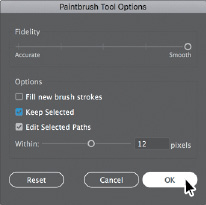
 ) in the Tools panel to display the Paintbrush Tool Options dialog box, and make the
following changes:
) in the Tools panel to display the Paintbrush Tool Options dialog box, and make the
following changes:
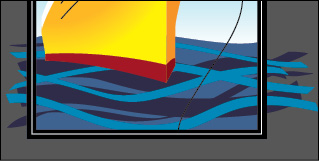
 ) or by selecting a segment or point on the path with the Direct Selection tool (
) or by selecting a segment or point on the path with the Direct Selection tool ( ) and then redrawing part of the path with the Paintbrush tool, like you saw previously.
) and then redrawing part of the path with the Paintbrush tool, like you saw previously.
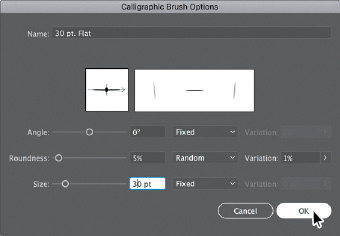
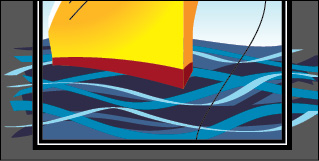
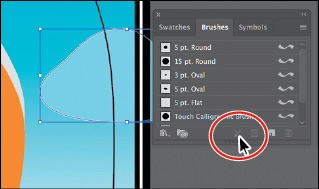
 ) at the bottom of the Brushes panel.
) at the bottom of the Brushes panel.
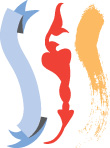
 ) at the bottom of the Brushes panel, and choose Artistic > Artistic_Paintbrush.
) at the bottom of the Brushes panel, and choose Artistic > Artistic_Paintbrush.
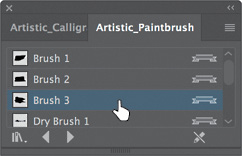
 ), and choose List View. Click the brush named “Brush 3” in the list to add the brush
to the Brushes panel for this document. Close the Artistic_Paintbrush panel group.
), and choose List View. Click the brush named “Brush 3” in the list to add the brush
to the Brushes panel for this document. Close the Artistic_Paintbrush panel group.
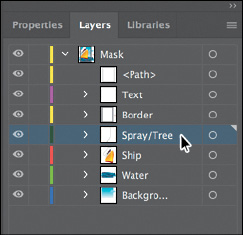




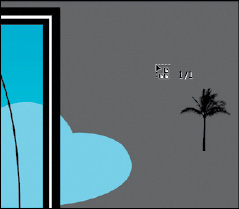
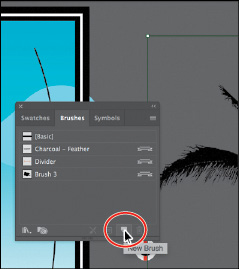
 ) at the bottom of the Brushes panel. This begins the process of creating a new brush
from the selected raster artwork.
) at the bottom of the Brushes panel. This begins the process of creating a new brush
from the selected raster artwork.
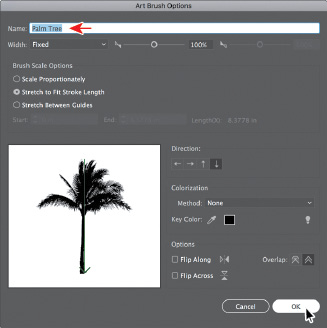
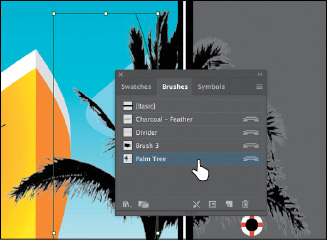
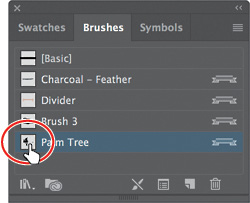
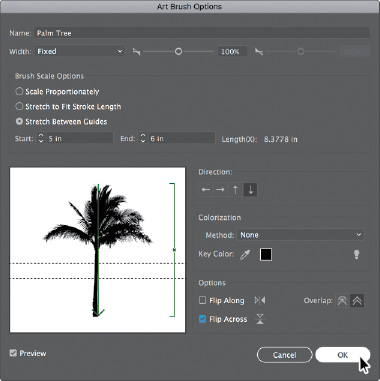

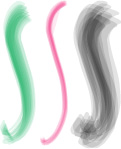

 ) at the bottom of the Brushes panel, and choose Bristle Brush > Bristle Brush Library.
) at the bottom of the Brushes panel, and choose Bristle Brush > Bristle Brush Library.
 ) in the Tools panel, and click a few times, slowly, on the smoke shape above the
ship (not the cloud) to zoom in on it.
) in the Tools panel, and click a few times, slowly, on the smoke shape above the
ship (not the cloud) to zoom in on it.
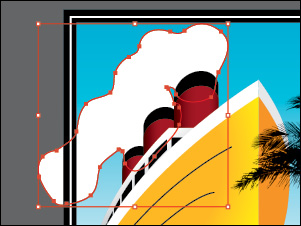
 ) at the bottom of the Tools panel.
) at the bottom of the Tools panel.
 ) at the bottom of the Tools panel, and then choose Draw Inside from the menu that
appears.
) at the bottom of the Tools panel, and then choose Draw Inside from the menu that
appears.
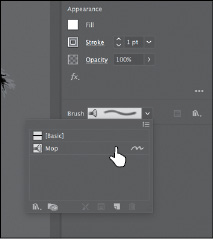

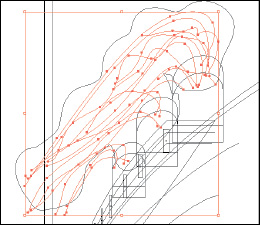
 ) at the bottom of the Tools panel.
) at the bottom of the Tools panel.
 ) in the Properties panel.
) in the Properties panel.

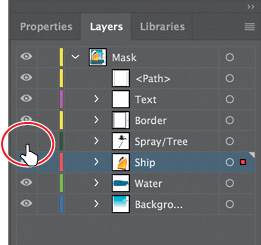
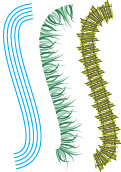
 ), and choose a library from one of the menus (the Decorative menu, for example).
), and choose a library from one of the menus (the Decorative menu, for example).
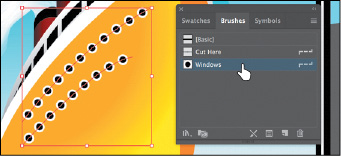
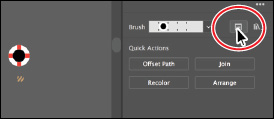
 ) in the Properties panel to edit the brush options for only the selected path on
the artboard.
) in the Properties panel to edit the brush options for only the selected path on
the artboard.

 ) at the bottom of the Brushes panel.
) at the bottom of the Brushes panel.
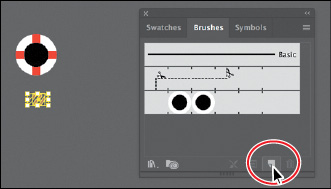

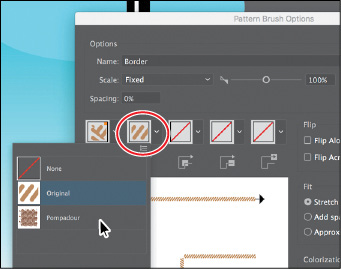
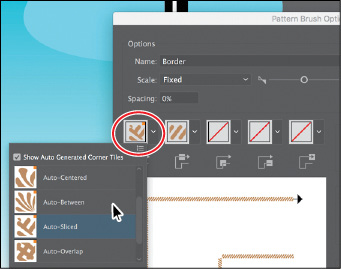
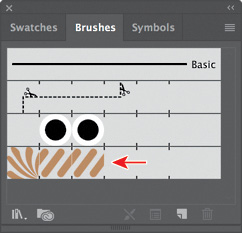
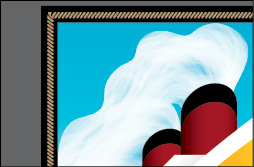
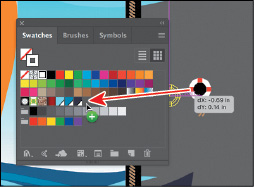
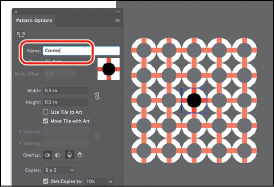
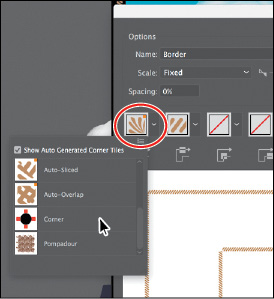
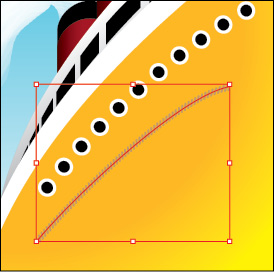
 ) in the Brushes panel. In this case, you chose Edit > Undo Apply Pattern Brush instead,
because clicking the Remove Brush Stroke button would strip the previous formatting
from the path, leaving it with a default fill and stroke.
) in the Brushes panel. In this case, you chose Edit > Undo Apply Pattern Brush instead,
because clicking the Remove Brush Stroke button would strip the previous formatting
from the path, leaving it with a default fill and stroke.
 ) to paint filled shapes that intersect and merge with other shapes of the same color.
With the Blob Brush tool, you can draw with Paintbrush tool artistry. Unlike the Paintbrush
tool, which lets you create open paths, the Blob Brush tool lets you create a closed
shape with a fill only (no stroke) that you can then easily edit with the Eraser or
Blob Brush tool. Shapes that have a stroke cannot be edited with the Blob Brush tool.
) to paint filled shapes that intersect and merge with other shapes of the same color.
With the Blob Brush tool, you can draw with Paintbrush tool artistry. Unlike the Paintbrush
tool, which lets you create open paths, the Blob Brush tool lets you create a closed
shape with a fill only (no stroke) that you can then easily edit with the Eraser or
Blob Brush tool. Shapes that have a stroke cannot be edited with the Blob Brush tool.


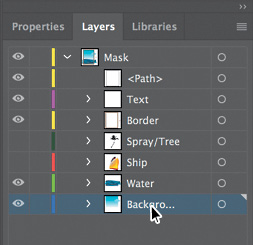
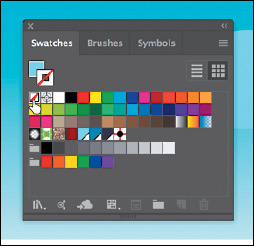



 ) and ensure that the fill color is the light blue swatch and the stroke is None in
the Properties panel. Then you can select the Blob Brush tool and try dragging from
one cloud to the other.
) and ensure that the fill color is the light blue swatch and the stroke is None in
the Properties panel. Then you can select the Blob Brush tool and try dragging from
one cloud to the other.

 ) in combination with the Blob Brush tool to mold the shape and to correct any changes
you don’t like.
) in combination with the Blob Brush tool to mold the shape and to correct any changes
you don’t like.


 ) at the bottom of the Layers panel.
) at the bottom of the Layers panel.

 ) and applying a brush to artwork using one of the drawing tools?
) and applying a brush to artwork using one of the drawing tools?
 ) allow you to create?
) allow you to create?
 ), if a brush is chosen in the Brushes panel and you draw on the artboard, the brush
is applied directly to the paths as you draw. To apply brushes using a drawing tool,
you select the tool and draw in the artwork. Then
), if a brush is chosen in the Brushes panel and you draw on the artboard, the brush
is applied directly to the paths as you draw. To apply brushes using a drawing tool,
you select the tool and draw in the artwork. Then  ) to select a path and then edit it.
) to select a path and then edit it.
 ) to edit filled shapes that you can intersect and merge with other shapes of the
same color or to create artwork from scratch.
) to edit filled shapes that you can intersect and merge with other shapes of the
same color or to create artwork from scratch.